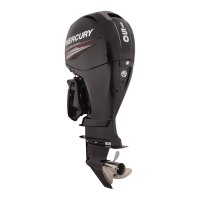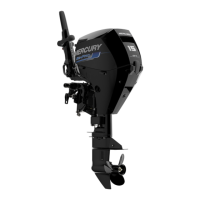GENERAL INFORMATION
10
Propellers are designated by the diameter, pitch, number of blades, and material. The diameter and pitch
are stamped (cast) into the side or the end of the propeller hub. The first number represents the diameter
of the propeller and the second number represents the pitch. For example, 14x19 represents a propeller
with a 14 inch diameter and 19 inches of pitch.
a - Diameter b - Pitch - Travel during one revolution
The following are some propeller basics that will help you determine the correct propeller for your boating
application.
Diameter - The diameter is the distance across the imaginary circle that is made when the propeller
rotates. The correct diameter for each propeller has been predetermined for the design of your outboard.
However, when more than one diameter is available for the same pitch, use a larger diameter for heavy
boat applications and a smaller diameter for lighter applications.
Pitch - The pitch is the theoretical distance, in inches, that a propeller travels forward during one
revolution. Pitch can be thought of similar to gears in a car. The lower the gear, the faster the car will
accelerate, but with lower overall top speed. Likewise, a lower pitch propeller will accelerate quickly, but
top-end speed will be reduced. The higher the propeller pitch the faster the boat will usually go; though
typically slowing acceleration.
Determining the Correct Pitch size - First, check the full throttle RPM under normal load condition. If the
full throttle RPM is within the recommended range, select a replacement or upgrade propeller with the
same pitch as the current propeller.
• Adding 1 inch of pitch will reduce the full throttle RPM by 150 to 200
• Subtracting 1 inch of pitch will increase full throttle RPM by 150 to 200
• Upgrading from a 3-blade propeller to a 4-blade propeller will generally decrease full throttle RPM
by 50 to 100
IMPORTANT: Avoid damage to the engine. Never use a propeller which allows the engine to exceed
the recommended full throttle RPM range when under normal full throttle operation.
PROPELLER MATERIAL
Most propellers manufactured by Mercury Marine are made from either aluminum or stainless steel.
Aluminum is suitable for general purpose use and is standard equipment on many new boats. Stainless
steel is over five times more durable than aluminum and typically provides performance gains in
acceleration and top end speed due to design efficiencies. Stainless steel propellers also come in a
larger variety of sizes and styles that allow you to dial in the ultimate performance for your boat.
3 BLADE VS. 4 BLADE
Available in many sizes of both aluminum and stainless, 3 and 4-blade propellers have unique
performance characteristics. In general, 3-blade propellers offer good all around performance and higher
top speed than 4-blade propellers. However, 4-blade propellers are usually faster to plane and more
efficient at cruising speeds, but lack the top end speed of a 3-blade propeller.

